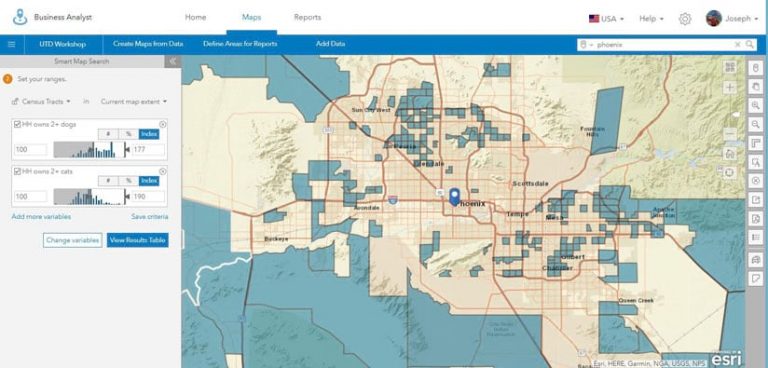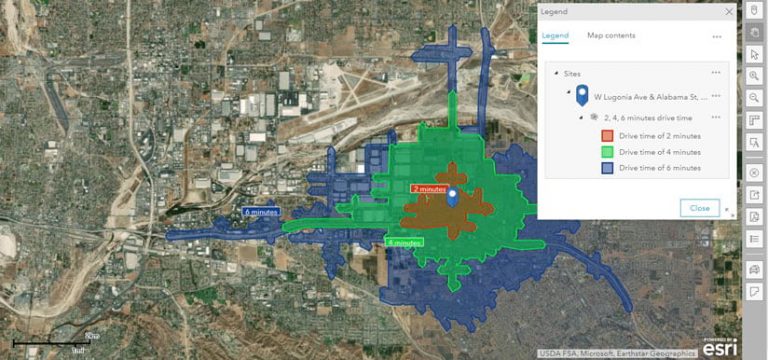Business Schools Begin to Introduce Students to Location Analytics
While many aspects of business such as site selection and supply chain management are directly related to location analytics, business schools have only recently started to offer courses on the subject in Master of Business Administration (MBA) and Master of Science in Supply Chain Management (MS SCM) programs.
In the interview that follows, Joseph J. Kerski talks about the benefits and challenges of adding location analytics into the course curricula of these programs. Kerski is an education manager at Esri, a longtime educator, and a GIS professional.
How is location analytics being worked into the MBA and MS SCM course curricula?
Kerski: In business, location matters. Because location analytics tools and geospatial data are increasingly used in business workplaces, university faculty are including location analytics principles and applications more and more in their business courses and programs. As societal and educational needs change, they realize that geotechnologies coupled with spatial thinking in their teaching and research are ways in which universities can remain relevant and innovative.

How will students benefit from learning location analytics in their classes?
Kerski: Students who rigorously use location analytics in their courses develop critical thinking and spatial thinking skills. GIS has always been a “thinker’s tool” for solving problems from a local to global scale.
When students use location analytics, they get the opportunity to work with a large volume and variety of data. And when they work with ArcGIS StoryMaps or other web mapping apps, they learn oral and digital communication skills.
Students get valuable experience in decision-making, helping them stand out among the thousands of business school graduates each year who have marketable skills that are in demand in the workplace.
Furthermore, much of Esri’s location analytics technology, such as ArcGIS Online and ArcGIS Business Analyst Web, is now cloud-based and capable of being accessed anytime, anywhere, and on any device. That makes it easier for students to use.
What’s challenging about introducing location analytics into these curricula?
Kerski: Like all large organizations, educational institutions—such as community colleges and universities—include a diverse set of people, programs, and goals. They need to see a positive return on investment for any tools and approaches before widely adopting them.
Plus, location analytics tools often are updated rapidly, and the spatial data behind the tools can change quickly too. That makes it a challenge to determine how and in which course activities the technology should be used.
Using any professional tool presents a double challenge to faculty members. They must be comfortable with the tools to use them in the courses that they teach and understand why and how to effectively teach with them.
Location analytics is part of a geographic information system that contains many interlocking components. Deciding which of the components to use in teaching—and in what manner to do so—takes effort. However, teaching with inquiry-driven approaches and tools helps students learn. And when students learn with location analytics, they become much more marketable no matter which aspects of business they choose to pursue.

You advised Professor William Ritchie at James Madison University about a course he recently taught called Introduction to Supply Chain Management. Did he have the students use location analytics?
Kerski: Ritchie, CSX professor of management, has been using location analytics in the university’s supply chain management program for the last three years.
Most recently, with the disruption caused by coronavirus disease 2019 (COVID‑19), Ritchie created and taught Introduction to Supply Chain Management entirely online. It’s a five-week course.
In the class, he used location analytics as its primary framework, asking the students to investigate such spatial problems as the impact of COVID‑19 on hospital certification visits and staffing shortages in distribution centers. The students also mapped the distribution of Starbucks restaurants and tracked maritime vessels using ArcGIS Online tools and remotely sensed data.
How did the students respond to the class? Was there interest in learning more about the capabilities of location analytics and its application to business and supply chain management?
Kerski: The students overwhelmingly said that the ArcGIS Online tools, which they used to examine patterns, relationships, and trends across space and time, were very engaging. After each of the supply chain management tenets were explained—such as risk assessment and the origin–destination matrix—students could immediately apply what they learned by working with real data in real-world scenarios and at multiple scales, from local to regional to global. Since the tools being used were part of the ArcGIS Online platform, and the data was accessed as online data services, this approach meshed perfectly with conducting the course using an online learning management system (LMS)—in this case, Canvas.

Esri and Texas Christian University are developing a program to introduce location analytics into business and supply chain management graduate school programs. Please describe that program.
Kerski: Location analytics has long been integral to Texas Christian University’s GIS courses. In the introductory course, lab assignments give students experience using GIS in thematic areas such as demographic analysis, market research, and urban environmental change. In another course, Urban and Business Applications of GIS, students gain experience applying GIS to solve real-world urban and business problems.
Topics for the graduate school program being developed include demographic analysis, remote sensing of urban areas, network analysis, 3D urban modeling, spatial statistics, temporal analysis, geodemographic classification, market area analysis, and Web GIS services. Students will also complete a semester-long group project that applies GIS to assist an organization or business in the area where the school is located.
Does Esri have other upcoming initiatives to introduce location analytics to MBA and MS SCM students?
Kerski: For nearly 30 years, the Esri education industry team has supported educational institutions in GIS teaching, research, and administration.
In the past several years, Esri has created resources to assist faculty who seek to use location analytics in colleges of business. These resources include a new business education landing page along with key messages and sample activities.
Recently, Esri—along with case provider Chick-fil-A—supported Texas Christian University’s (TCU) Neely Center for Supply Chain Innovation’s Graduate Supply Chain Case Competition. The competition addressed the challenges of supporting high supply chain growth in seven western states.
Each team of students was tasked with expanding distribution networks to meet customer demand for Chick-fil-A products by taking into account demographics, consumer behaviors, and natural seasonality. Teams were provided with GIS software from Esri to do the mapping and analysis.
Esri was recently selected as an industry partner for the University of California, San Diego Rady School of Management’s Master of Science in Business Analytics student capstone project.
In the project and program, students used ArcGIS Business Analyst Web App, R, ArcGIS Online, and other tools to propose the most commercially viable use for a parcel outside Redlands, California.
Students approached the problem from a data science perspective, creating a set of stories in ArcGIS StoryMaps to present their results.
The University of Redlands School of Business and Esri also have joined in a spatial business initiative.
In addition, Esri is honored to be an adviser for the Location Analytics for Business courses at the W. P. Carey School of Business at Arizona State University. This course is included in the 18 credit hours required for a certificate in applied business data analytics, providing rigorous exposure to predictive analytics and modeling, big data techniques, and visualization.
Is there anything else that you would like to add?
Kerski: All of us at Esri are deeply committed to the value of GIS throughout society, including all disciplines and all levels of education. We want to be considered as a trusted partner that universities can count on to assist them as they chart their course ahead.
To learn more and connect with the GIS education community, visit the Education Space on GeoNet.
